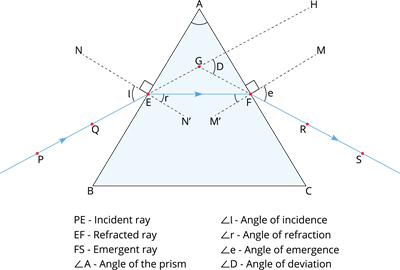
PUMPA - SMART LEARNING
எங்கள் ஆசிரியர்களுடன் 1-ஆன்-1 ஆலோசனை நேரத்தைப் பெறுங்கள். டாப்பர் ஆவதற்கு நாங்கள் பயிற்சி அளிப்போம்
Book Free DemoIn the previous section, we have learned the refraction of light through a glass slab. In this section, we discuss the refraction of light through a glass prism.
How would the refraction of light take place through a transparent prism?
Let us consider a triangular glass prism that has two triangular bases and three rectangular lateral surfaces. These surfaces are inclined to each other. The angle between its two lateral surfaces is known as the angle of the prism.
Let us now do an activity to study the refraction of light through a triangular glass prism.
How would the refraction of light take place through a transparent prism?
Let us consider a triangular glass prism that has two triangular bases and three rectangular lateral surfaces. These surfaces are inclined to each other. The angle between its two lateral surfaces is known as the angle of the prism.
Let us now do an activity to study the refraction of light through a triangular glass prism.
Activity:
- Place a sheet of white paper using drawing pins on a drawing board.
- Locate a glass prism on the whitepaper in such a way that it rests on its triangular base. Sketch the outline of the prism by using a pencil.
- Sketch a straight line \(PE\) inclined to one of the refracting surfaces, consider \(AB\), of the prism.

Refraction of light through a glass prism
- Locate two pins, say at points \(P\) and \(Q\), on the line \(PE\) as shown in the figure.
- Look for the images of the pins, located at \(P\) and \(Q\), through the other surface \(AC\).
- Locate two more pins at points \(R\) and \(S\), such that the pins located at \(R\) and \(S\) and the images of the pins at \(P\) and \(Q\) rest on the same straight line.
- Remove the pins and the glass prism.
- The line PE coincides with the boundary of the prism at point \(E\) (see the figure). Similarly, connect and produce the points \(R\) and \(S\). Let these lines meet the prism boundary at \(E\) and \(F\), respectively. Connect \(E\) and \(F\).
- Sketch perpendiculars to the refracting surfaces of the prism \(AB\) and \(AC\) at points \(E\) and \(F\), respectively.
- As shown in the figure, mark the angle of incidence (\(\angle i\)), the angle of refraction (\(\angle r\)) and the angle of emergence (\(\angle e\)).
We will discuss in detail about the angle of incidence (\(\angle i\)), the angle of refraction (\(\angle r\)) and the angle of emergence (\(\angle e\)) in the upcoming sections.